Donate now to support the LLIFLE projects.
Your support is critical to our success.
Your support is critical to our success.
= Echinopsis aurea var. sierragrandensis (Rausch) J.G.Lamb.
Succulenta (Netherlands) 67(9): 182 1988
Accepted Scientific Name: Echinopsis aurea Britton & Rose
Cactaceae (Britton & Rose) 3: 74. 1922 [12 Oct 1922] Britton & Rose
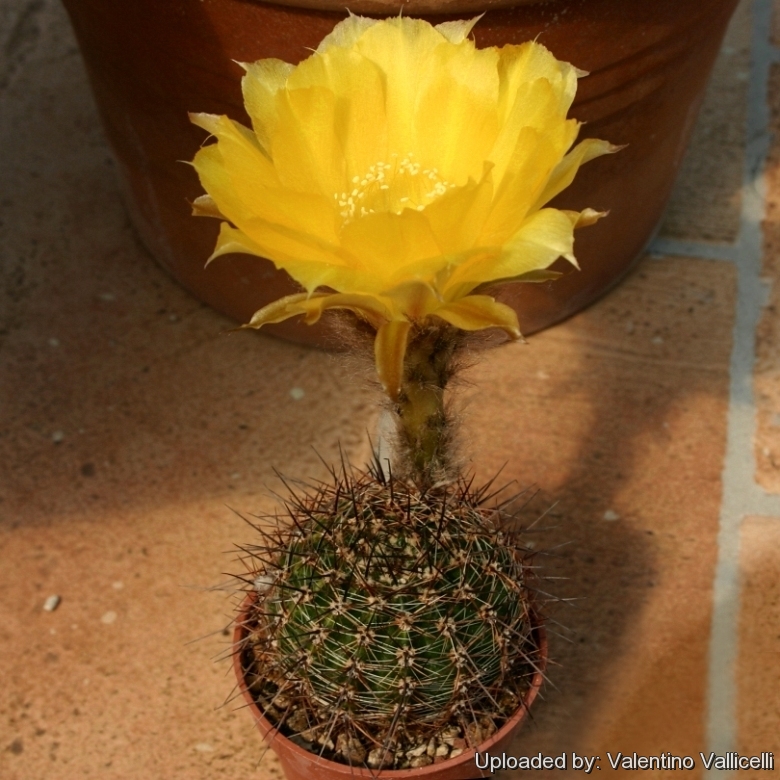
Lobivia aurea var. sierragrandensis (Echinopsis aurea var. sierragrandensis) Photo by: Valentino Vallicelli
It has long thin spines. The radials are whitish wile the centrals are thicker reddishi-brown to blackish with yellow tips.
It has long thin spines. The radials are whitish wile the centrals are thicker reddishi-brown to blackish with yellow tips.
Synonyms:
- Echinopsis aurea var. sierragrandensis (Rausch) J.G.Lamb.
See all synonyms of Echinopsis aurea
back
Accepted name in llifle Database:Echinopsis aurea Britton & Rose
Cactaceae (Britton & Rose) 3: 74. 1922 [12 Oct 1922]
Synonymy: 96
- Echinopsis aurea Britton & Rose
- Hymenorebutia aurea (Britton & Rose) F.Ritter
- Lobivia aurea (Britton & Rose) Backeb.
- Lobivia shaferi subs. aurea (Britton & Rose) E.Herzog
- Pseudoechinopsis aurea (Britton & Rose) W.R.Abraham
- Pseudolobivia aurea (Britton & Rose) Backeb.
- Salpingolobivia aurea (Britton & Rose) Y.Itô
- Echinopsis ancastii
- Echinopsis aurea var. albiflora (Rausch) J.Ullmann
- Echinopsis fallax var. albiflora (Rausch) J.G.Lamb.
- Lobivia aurea var. albiflora Rausch
- Lobivia shaferi var. albiflora (Rausch) E.Herzog
- Echinopsis aurea var. callochrysea (F.Ritter) J.Ullmann
- Echinopsis fallax var. callochrysea (F.Ritter) J.G.Lamb.
- Hymenorebutia aurea var. callochrysea F.Ritter
- Lobivia aurea var. callochrysea (F.Ritter) Rausch
- Echinopsis aurea var. catamarcensis (F.Ritter) J.Ullmann
- Echinopsis fallax var. catamarcensis (F.Ritter) J.G.Lamb.
- Hymenorebutia aurea var. catamarcensis F.Ritter
- Lobivia aurea var. catamarcensis (F.Ritter) Rausch
- Echinopsis aurea var. cylindrica (Backeb.)
- Echinopsis fallax var. cylindrica (Backeb.) J.G.Lamb.
- Hymenorebutia aurea var. cylindrica (Backeb.) F.Ritter
- Lobivia cylindrica Backeb. in Backeb. & F.M.Knuth
- Pseudoechinopsis cylindrica (Backeb.) W.R.Abraham
- Salpingolobivia cylindrica (Backeb.) Y.Itô
- Echinopsis aurea var. depressicostata (F.Ritter) J.Ullmann
- Echinopsis fallax var. depressicostata (F.Ritter) J.G.Lamb.
- Hymenorebutia aurea var. depressicostata F.Ritter
- Lobivia aurea var. depressicostata (F.Ritter) Rausch
- Echinopsis aurea var. dobeana (Dölz) J.Ullmann
- Cereus huascha var. rubriflorus Speg. non F.A.C.Weber
- Echinopsis dobeana (Dölz) J.G.Lamb.
- Lobivia aurea var. dobeana (Dölz) Rausch
- Lobivia dobeana Dölz
- Echinopsis aurea var. elegans
- Lobivia aurea var. elegans Backeb.
- Pseudoechinopsis aurea f. elegans (Backeb.) W.R.Abraham
- Pseudolobivia aurea var. elegans Backeb.
- Echinopsis aurea subs. fallax (Oehme) M.Lowry
- Echinopsis aurea var. fallax (Oehme) J.Ullmann
- Echinopsis fallax (Oehme) Friedrich
- Lobivia aurea var. fallax (Oehme) Rausch
- Lobivia fallax Oehme
- Lobivia shaferi subs. fallax (Oehme) E.Herzog
- Pseudoechinopsis aurea var. fallax (Oehme) W.R.Abraham
- Pseudolobivia aurea var. fallax (Oehme) Backeb.
- Echinopsis aurea var. grandiflora (Backeb.)
- Lobivia aurea var. grandiflora Backeb.
- Pseudoechinopsis aurea f. grandiflora (Backeb.) W.R.Abraham
- Echinopsis aurea var. lariojensis (F.Ritter) J.Ullmann
- Hymenorebutia aurea var. lariojensis F.Ritter
- Echinopsis aurea f. luteiflora (Backeb.)
- Lobivia shaferi f. luteiflora (Backeb.) E.Herzog
- Pseudolobivia luteiflora Backeb.
- Echinopsis aurea var. mizquiensis
- Echinopsis aurea var. quinesensis Rausch
- Echinopsis quinesensis (Rausch) H.Friedrich & Glaetzle
- Hymenorebutia quinesensis (Rausch) F.Ritter
- Lobivia aurea var. quinesensis (Rausch) G.D.Rowley
- Lobivia shaferi var. quinesensis (Rausch) E.Herzog
- Pseudoechinopsis aurea var. quinesensis (Rausch) W.R.Abraham
- Echinopsis aurea var. rubriflora (E.Herzog)
- Lobivia shaferi var. rubriflora E.Herzog
- Echinopsis aurea subs. shaferi (Britton & Rose) M.Lowry
- Echinopsis aurea var. shaferi (Britton & Rose) Rausch
- Echinopsis fallax var. shaferi (Britton & Rose) Lamb.
- Echinopsis shaferi Britton & Rose
- Lobivia aurea var. shaferi (Britton & Rose) Rausch
- Lobivia shaferi Britton & Rose
- Pseudoechinopsis aurea var. shaferi (Britton & Rose) W.R.Abraham
- Salpingolobivia shaferi (Britton & Rose) Y.Itô
- Echinopsis aurea subs. shaferi f. monstruosa cristata hort.
- Echinopsis aurea subs. shaferi f. monstruosa hort.
- Echinopsis aurea var. sierragrandensis (Rausch) J.G.Lamb.
- Echinopsis aurea var. tortuosa (Rausch) J.Ullmann
- Echinopsis fallax var. tortuosa (Rausch) J.G.Lamb.
- Lobivia aurea var. tortuosa Rausch
- Echinopsis cylindracea (Backeb.) Friedrich
- Lobivia cylindracea Backeb.
- Lobivia shaferi f. cylindracea (Backeb.) E.Herzog
- Echinopsis leucomalla (Wessner) Friedrich
- Echinopsis densispina f. leucomalla (Wessner) Buining
- Hymenorebutia leucomalla (Wessner) Buining
- Lobivia aurea var. leucomalla (Wessner) Rausch
- Lobivia densispina f. leucomalla (Wessner) Buining
- Lobivia famatimensis var. leucomalla (Wessner) Backeb.
- Lobivia leucomalla Wessner
- Lobivia leucomalla var. rubispina Wessner
- Lobivia shaferi subs. leucomalla (Wessner) E.Herzog
- Pseudoechinopsis aurea var. leucomalla (Wessner) W.R.Abraham
back
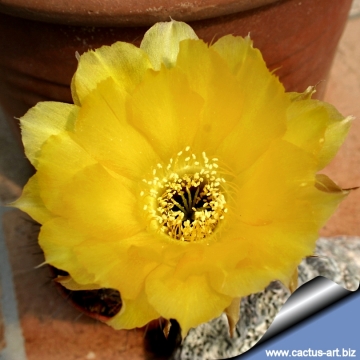
Lobivia aurea var. sierragrandensis (Echinopsis aurea var. sierragrandensis) Photo by: Cactus Art
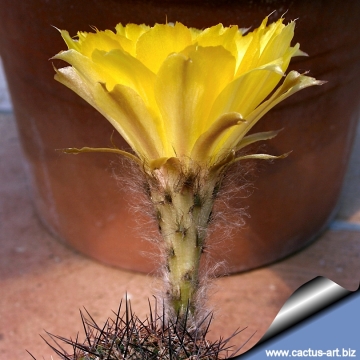
Lobivia aurea var. sierragrandensis (Echinopsis aurea var. sierragrandensis) Photo by: Cactus Art
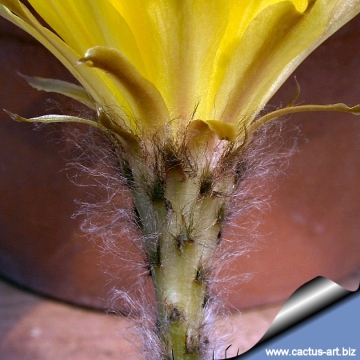
Lobivia aurea var. sierragrandensis (Echinopsis aurea var. sierragrandensis) Photo by: Cactus Art
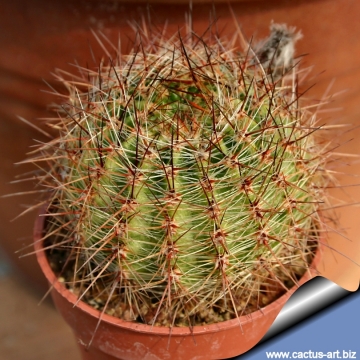
Lobivia aurea var. sierragrandensis (Echinopsis aurea var. sierragrandensis) Photo by: Cactus Art
| Your Actions | |
|---|---|
| Back to Lobivia index | |
| Back to Cactaceae index | |
 |
Back to Cacti Encyclopedia index |








